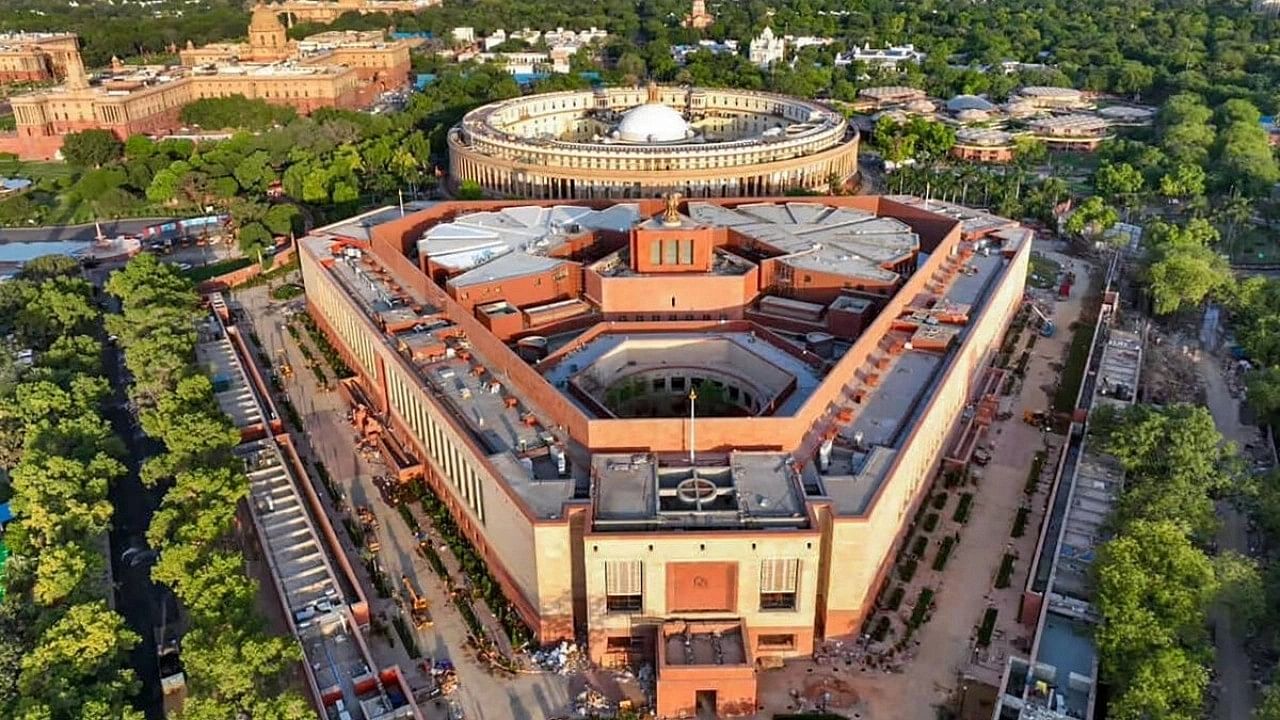
File photo of the new parliament building.
Credit: PTI Photo
New Delhi: The statues of Mahatma Gandhi, BR Ambedkar and 13 such national icons spread across the parliament complex have been relocated to a new enclosure on its premises, 'Prerana Sthal', following discussions with different stakeholders, Lok Sabha Speaker Om Birla said on Sunday.
The relocation of the statues, he said, were done as part of a landscaping and beautification exercise.
Following the exercise, there was an uproar, even as the new location was being inaugurated by Vice President Jagdeep Dhankar. He was accompanied by Birla himself and also Deputy Rajya Sabha Chairman Harivansh Narayan Singh and Parliamentary Affairs Minister Kiren Rijiju.
“None of the statues have been removed, they have been relocated. There is no need to indulge in politics on this,” Birla said, commenting on the uproar over the matter.
“From time to time, I have been discussing these issues with different stakeholders. People were of the view that having these statues at one place will help disseminate information about their lives and achievements in a better way,” he added.
The statues of Mahatma Gandhi and B R Ambedkar, earlier located at prominent places on the Parliament premises, were places where opposition leaders gathered to protest against the government.
Congress general secretary (communications) Jairam Ramesh, who has been raising the issue, said that the Parliament’s Committee on Portraits and Statues last met on December 18, 2018, as per the website of the lower house.
“It was not even reconstituted during the 17th Lok Sabha (2019-2024), which also functioned for the first time without the Constitutional post of Deputy Speaker. Today, a major reconfiguration of statues in the Parliament complex is being inaugurated. Clearly it is a decision taken by the ruling regime unilaterally,” he posted on X.
The Lok Sabha Secretariat, in a statement released last week, said that "an action plan" was made to ensure the stories of these leaders reached visitors via technology.
"Due to location at different places in the Parliament Complex, visitors were not able to view these statues conveniently. For this reason, all these statues are being respectfully installed in a grand Prerana Sthal in the Parliament House Complex itself,” the statement said.
“In this Prerana Sthal, arrangements are also being made to provide detailed information to the visitors through modern technology regarding the lives and contributions of our great freedom fighters so that the people coming to visit them could get inspiration from their lives and thoughts,” it added.
Birla said the Prerana Sthal, located on the lawns between the old Parliament building and the Parliament library building, will be open to visitors all through the year and host commemoration days to honour the contribution of the leaders to nation building.
The outer lawns of the Parliament complex have statues of national icons such as B R Ambedkar, Mahatma Gandhi, Mahatma Jyotiba Phule, Chhatrapati Shivaji, Maharana Pratap, Hemu Kalani, Mahatma Basaveshwara, Kittur Rani Channamma, Motilal Nehru, Maharaj Ranjit Singh, Durga Malla, Birsa Munda, Rajarshi Chhatrapati Shahu Maharaj, and Chaudhary Devi Lal.
Asked about the Central Industrial Security Force (CISF) taking over security of the entire Parliament complex, Birla said it was done so that accountability could be fixed on one agency.
Earlier, the Parliament Security Service, the Delhi Police and the Central Reserve Police Force were responsible for the security of the Parliament complex and there was certain overlap in responsibilities, he said.
The Lok Sabha speaker said CISF personnel were being trained on dealing with parliamentarians as the system of Parliament security was different from guarding other premises.
(With PTI Inputs)